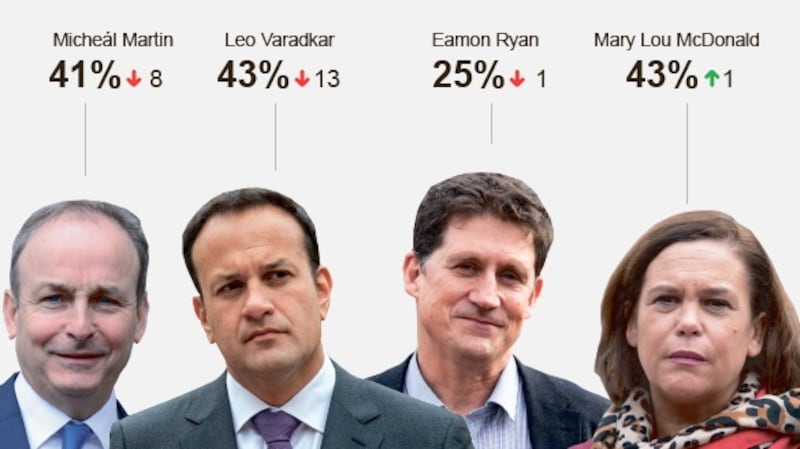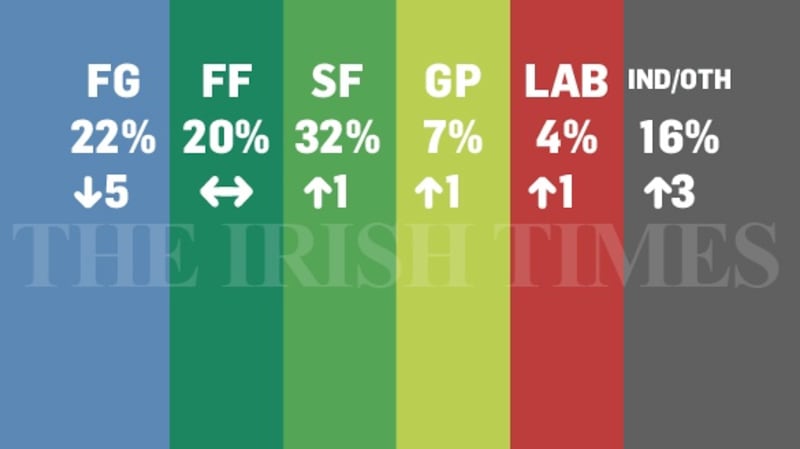One small step for Sinn Féin – up one point to 32 per cent – is enough to establish a considerable 10-point lead on Fine Gael, who drop five points to 22 per cent in the latest Irish Times/Ipsos MRBI poll.
Fianna Fáil are unchanged on 20 per cent, while the other main parties and groups register marginal gains – the Green Party is up one point to 7 per cent, Labour are up 1 point to four per cent, Social Democrats are up one point to 3 per cent, and Independents/Others are up three points to 16 per cent.
Solidarity/PBP (on 2 per cent) and Aontú (on 1 per cent) are each unchanged on our last poll in June.
Interviewing for today’s poll took place between October 2nd and 5th, in homes across every constituency in Ireland. A total of 1,200 interviews were conducted, with party support figures based on those giving a preference and indicating they are likely to vote in a general election.
As we emerge from the pandemic, it would not have been unreasonable for the Government parties to expect a bonus of sorts for having steered the country successfully through the crisis. Today’s poll suggests that any pandemic bonus has been largely spent.

From a high of 72 per cent in June last year, satisfaction with the Government has fallen to 46 per cent in this latest poll. Taoiseach Micheál Martin’s satisfaction rating has also dropped, to 41 per cent (from 49 per cent in June), as too has Tánaiste Leo Varadkar’s rating, down to 43 per cent (from 56 per cent in June). The business of politics, it seems, is returning to normal as fast as the pandemic is retreating.
Number one party
Sinn Féin emerges from today’s poll as the clear number one party in Ireland. A lead of 10 points is significant, even if historic polling data suggest such leads are often short-lived.
Sinn Féin have a history of performing strongly among young voters. Currently, 37 per cent of under 35s declare they will vote for Sinn Féin in the next election.
More recently, Sinn Féin has broadened its age profile, which has helped the party build the substantial lead it enjoys today. For example, exactly 10 years ago, just 5 per cent of those aged 65 years or older supported Sinn Féin. In our latest poll, the equivalent number is 27 per cent.

Among working-class voters, Sinn Féin attracts 42 per cent support, but even among the middle classes, approaching one in four (23 per cent) would give Sinn Féin their first preference.
Regionally, Sinn Féin is stronger outside the capital – Dublin 24 per cent, rest of Leinster 33 per cent, Munster 38 per cent and Connacht/Ulster 35 per cent.
Mary Lou McDonald is tied with Varadkar for the most popular party leader, with each recording a 43 per cent satisfaction rating.
Fine Gael have dropped five points, to 22 per cent – still above their 2020 general election performance, but the party’s lowest poll rating since entering Government last year. The drop has been most noticeable among those over 50 years of age, although the heights Fine Gael scaled among this cohort may have been fuelled by Varadkar’s handling of the initial response to the pandemic, so some softening was inevitable.
Holding steady
Fianna Fáil are holding steady, at 20 per cent, having dipped in the polls immediately following the 2020 election. Longer term, some of the demographic data contained within today’s poll will give the party pause for thought. Fianna Fáil is struggling to connect with younger voters, even the under 25s (on 11 per cent) who are the least likely to be burdened by the baggage of past crises. For Fianna Fáil, the situation is retrievable as younger voters have been shown to be the least entrenched in their political preferences.
Fianna Fáil is weakest in Dublin (on 16 per cent) and strongest in Munster (on 25 per cent).
With the Green Party on 7 per cent, the combined Government party vote adds up to 49 per cent, one point shy of their total in 2020 when they came together to form a government. Interestingly, the Greens attract the same level of vote as they did just before they went into government, so no evidence yet that the party will ultimately pay a price at the polls for this decision.
Independents and other smaller parties combined are up three points to 16 per cent. Since the general election, their poll rating has dropped six points, while at the same time Sinn Féin have added seven points. Of course, these are not all the same voters, swapping allegiances between Independents/Others and Sinn Féin, but it is worth considering the growing attraction of Sinn Féin to Independent voters who may be looking for an alternative to Fine Gael and Fianna Fail.
No country has emerged unscathed from the pandemic, but the Irish Government has shown strong leadership, at least according to the Bloomberg’s Covid resilience ranking. However, a firm hand on the tiller has not delivered a lasting dividend for the Government parties. In fact, it may have added to the frustrations of a generation who now, post-pandemic, feel even more precariously employed and may be further still from their ambition of owning a home as the cost of building or buying a house continues to climb.
Damian Loscher is Ipsos MRBI managing director













